ELVIS

The deep collaboration between Set Decorator Bev Dunn SDSA, Production Designer/Costume Designer/Producer Catherine Martin, Production Designer Karen Murphy and Writer/Director/Producer Baz Luhrman…
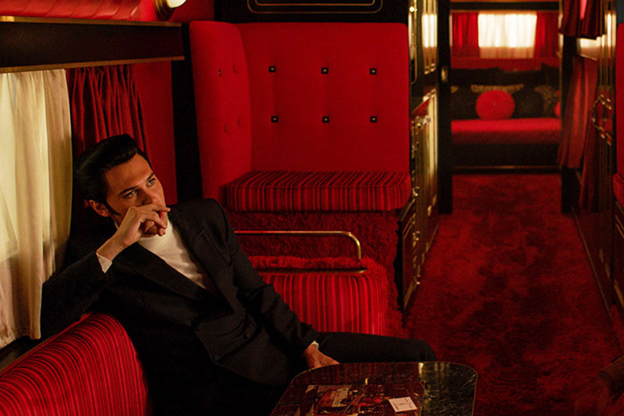
Set Decorator Bev Dunn SDSA, Production Designer Karen Murphy and Production Designer/Costume Designer/Producer Catherine Martin, creative and life partner of Writer/Director Baz Luhrman, give us such fascinating behind-the-scenes stories of the making of ELVIS that those bits could become tales themselves!
Lisa Clark SDSA represented SET DECOR in this in-depth interview which immediately turned into a dynamic conversation with memories and perspectives coming from each of these incredibly talented and thoughtful professionals and friends.
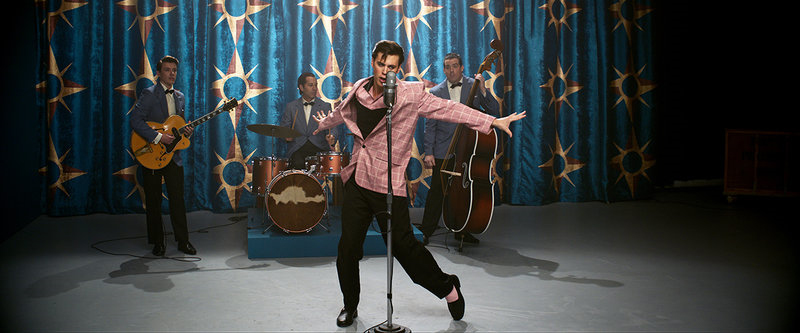
Lisa Clark SDSA for SETDECOR: The three of you have worked together for many years, and CM is, of course, Baz’s partner. Baz is known for his clear visual style as a director. Can you elaborate a bit on how the three of you work as a team to develop this unique style and in conjunction with Baz, because you have such a clear through-line with so many of your projects, and it would be interesting to hear about that.
Production Designer/Costume Designer/Producer Catherine Martin aka CM: Baz is so thorough, he does much research himself. What I enjoy about the collaboration is that with Baz, it’s very all encompassing, you’re immersed into his understanding of the world that he’s trying to create, and I really enjoy the process.
We have all worked together a lot, and I feel like everyone has their own strengths. I quite like the early phase, that phase of sort of knotting it out and working out what that world is going to be, how much of it we can afford to create, and just sort of planting the seed and building that up…
And I really enjoy working with Bev and Karen. Bev has a great understanding of what everybody in the team is doing. It’s almost like she’s done most of those roles herself! So, she sort of knows not only what everyone’s doing but also who can do what. I really benefit from her knowledge of all of that and her perspective about where things can come from…
Like, one idea that she had on ELVIS that turned out so great, was to print a carpet. We were looking at pictures of the carpet in the showroom at the International, the Hilton at that time, and we just could not find anything like it. So, Bev had artwork of the design created and the carpet actually printed! It literally matches the original photographs of the carpet. Just that sort of level of commitment and creative thinking, you know? We just weren’t going to settle for something that we could find in a store that looked only somewhat like the original. So we went through all that process, and that was a great thing to see when it came, when it was all rolled out.
Production Designer Karen Murphy: And how many kilometers? How much of that carpet did you actually print? It was ridiculous!
Set Decorator Bev Dunn SDSA: It was about five or six kilometers of carpet. It was insane. [Laughter]
Karen: And the curtain! Next to the carpet, the gold curtain was quite a feat as well, Bev. You should explain how that all came together. It was an incredible feat of Set Decorating
Lisa/SETDECOR: Yes, the amount of custom drapery in this film is daunting! So, Bev, if you could talk a little bit about the process of dealing with the volumes of drapery that you had to create, from things like the Revival tent, to Graceland, to all the stages, the giant Venetian stage curtain…it’s impressive.
Bev: It is impressive, and it was a little bit daunting, especially that the size of the gold curtain that had to be manufactured is actually bigger than any theater that currently exists in Australia. It was just the sheer quantity of fabric required was a little bit mind-blowing. Luckily, we were able to track down a fabric and have it dyed to our particular gold. There were problems in that when two of the rolls arrived, they were completely different dye lots! But we resolved it by putting them on the end. It was a process, and to actually find a company that was comfortable in making that size curtain here, without having to get it custom-made in America was key. Just in the shipping costs of that amount and in our timeframe to be airfreighted, it wasn’t really feasible. But it did all come together in the end, which was great.
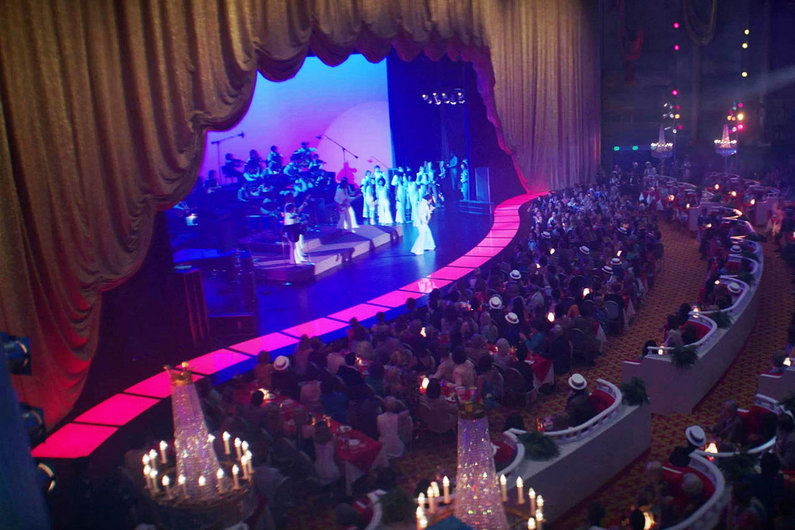
We did print fabric patterns for Elvis’s hotel room to match wallpaper, so we could have a very fluid theme throughout.
We also had custom-dyed waxed canvas in India to be able to get the canvas to a particular color for the tent and to a translucency for the light to come through, which is always a problem when we’re talking about fabrics. You know, how they’re going to light the actors beneath…
CM: And then there are really annoying things that are some of my specialties, things like I hate shots to be looking back at Elvis through the windows with the drapes ugly backside. So, the extra pain that I gave Bev was that I said “I want the curtains double-sided, so, if anytime during the day they come outside, we’re seeing the same print.” And it just did Mandy’s head in, [Editor’s note: Director of Photography Mandy Walker], because she was like, “But that’s not how they would be, there would be sheers on the other side.” There were big, long conversations about it, and in the end, we all agreed it was good to have them double-sided.
But what we forget now is that we had big supply chain issues, because we were doing this when half of the world was still locked down in COVID. I don’t know how Bev did it. Just the strength under fire, because there was always a problem, like not enough fabric, not enough manpower to actually print on a fabric to make the curtain, not enough manpower to actually make the curtain and get it there in time, you know, because we’re a huge country, but it’s only a population of 25 million people. So, it’s not unlimited, we certainly don’t have the labor resources of the States or Europe.
I’ve only seen Bev occasionally moist-eyed. [Laughter] And I remember on the Casino bedroom set, not all the curtains arrived to cover double-sided all the curtains. Bev came up to me, and said, ‘Look, we’re just not going to be able to do it, we’re going to have to turn some of them around.’ She was devastated. And, of course, it turned out perfectly…that’s her sort of absolutely indominable spirit…like the ability that she has to take on scale unflinchingly, huge scale at times, and to put up with Karen and me going, ‘Um, I’m not sure about that carpet, those flecks are a little bit not brown enough on that left-hand pattern square…and all Bev is thinking is…she will never say it, but ‘Will these two idiots hurry up? I’ve got five kilometers of carpet to print, and half an hour to do it in. I’ve got to get it laid, and here in Sydney, with constant shutdowns between states, and trucks not being able to get through.’ It was a mammoth task. And, Bev, didn’t you have people in-house making curtains as well?
Bev: We did. But then I found a really good company on the Gold Coast who handle a lot of supply manufacture, custom manufacture for the many hotels up on the Gold Coast and the casino there…I wish they were based in Sydney, where we’re working now! They were so efficient, and they had the facilities set up, so I actually relied on this couple and their team to fulfill the needs required. They had knowledge that surpassed mine with the draping and the quantities required for the draping. It was great to be able to rely on some people who do this full time. I think that’s why we ended up with some believable looking drapery, because it’s made by professionals as well.
Karen: I think that’s something to note that actually speaks to Bev’s strength and to working outside of the US type of system. I’m currently working in Los Angeles. For a particular set, I wanted to change all the shades out very quickly because I didn’t like something that came in. And there is a specific company in Los Angeles, who just does shades for the film industry. [Editor’s note: SDSA Business member AMCO American Screen & Window Coverings]
In Australia, you’ve got to go and find those people. Bev’s found people who work in the hotel industry or, you know, suppliers in India or somewhere else, because we just don’t have that infrastructure in Australia. You have people who are amazing at drapery, but you have to go into the real world and find them, and Bev has over the years. I’m always impressed by the people she finds to do things, whether it be a sailmaker who may make curtains, or someone else in an industry who can handle the scale and the time constraints that we have. So, that’s another thing on top of the stress of the enormity of the work, is just finding people to do it.
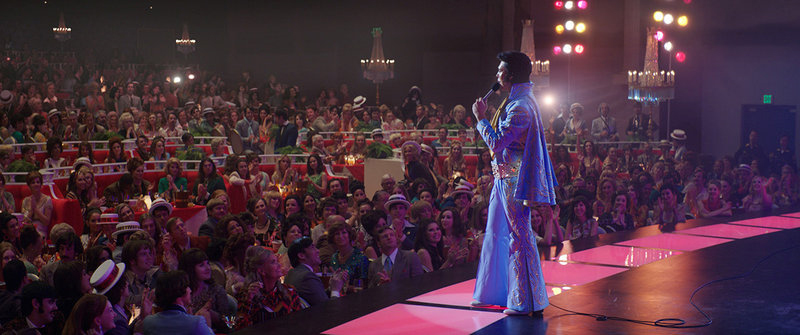
Lisa/SETDECOR: You know, to your point, Karen, I found in my own experience, one of the challenges of working with vendors outside of the industry, is getting them to understand the timetable. You were dealing with that, and then the pandemic on top of it! Can you give some examples of how do you wrangle those kinds of vendors in that environment? That would be very challenging.
Bev: Pay them healthily! Bribe them! [laughter] Again, we were filming this in the height of COVID. And I had to rely on Interstate vendors…the carpet was being printed in Melbourne, the fabrics were being printed in Sydney, we were filming on the Gold Coast, in Brisbane. I could get the vendors to print and make the time frame, but it was the freight that was the problem, because freight just went on a complete standstill, even with our own in-house freight companies. We achieved every deadline, but it was very close to the wire. And thank goodness for these interstate suppliers, because, again, Brisbane, where we were filming, just couldn’t print the carpet within our timeframe. So, you’ve just got to always come up with another option. And that’s just how we have to work…we’ve got a problem, and we’ve got to find a solution. So, someone can say “No” to me, and then it’s like [huge intake of breath, then lilting voice], “Well, we’ll make another phone call.” [Laughter] And that’s what we did, and that’s how we got it in front of camera.
Karen: I think it’s also that it sort of comes from the top, too. I’m sure Bev & CM would agree that Baz doesn’t want to hear “No.” So, you always try to come up with a creative solution. You don’t want to ever be presenting problems. And I think a lot of the real triumphs, at least for the films I’ve worked on with this team, are things that we think, ‘Oh, no, we’ve got to go down that road!” And it ends up being far superior and a better option in the end, you know.
CM: I think, too, having three collaborators that have worked together for such a long period of time, we know how to pivot. And, you know, Baz is uncompromising, but he’s also not, for want of a better word, an idiot. So, he doesn’t want you to say, ‘We can’t make 500 million curtains.’ He wants you to come and say, ‘Okay, well, because of this, we think this other is a better way of doing it, because otherwise we’re not going to be able to get this on time.’ And invariably, because there has been an intense collaboration before that point, the solution is accepted…there’s obviously been care and thought, and a huge amount of work has gone into the team coming up with something that we feel is a great alternative.
Bev: Also, the beauty of working with Baz and this team is that, if we put something in front of camera, he’s going to shoot it, because he always uses the sets as a visual form of storytelling. And that’s something that I strive for. We don’t want something ending up on the cutting room floor, we want to be able to offer up the best possible option, because in the overall vision, it’s going to look fantastic. You get the set there, the talented actors, the costumes period-correct, and it just is a really wonderful form of storytelling.
CM: And he really, really cares about the set dressing, like that, to him, is the set.
We’ve had conflict with first assistants who have basically stripped the set so they can move the camera in…He wants to walk on to a completely dressed set. He uses the dressing. He thinks about every element that is in a shot, and whether it’s something that crosses over…I think that so much of what Bev does really crosses into propping because every item that is in those rooms tells the story for Baz of the character who’s in the room. And so, he’ll want to walk through the set. He’ll stand in front of the curtains for hours. He’ll walk on the carpet. He’ll look at every detail of dressing.
And I think one of Bev’s triumphs in this movie is the Colonel’s suite. You know, everybody from Baz to the entire crew, they just walked on the set and they were completely in the Colonel’s brain. The level of detail and the tirelessness and amount of stuff that Bev gets, because she’s learned in 30 years, that what to a normal person would be enough is not even a drop in the bucket of an ocean of water for Baz Luhrmann.
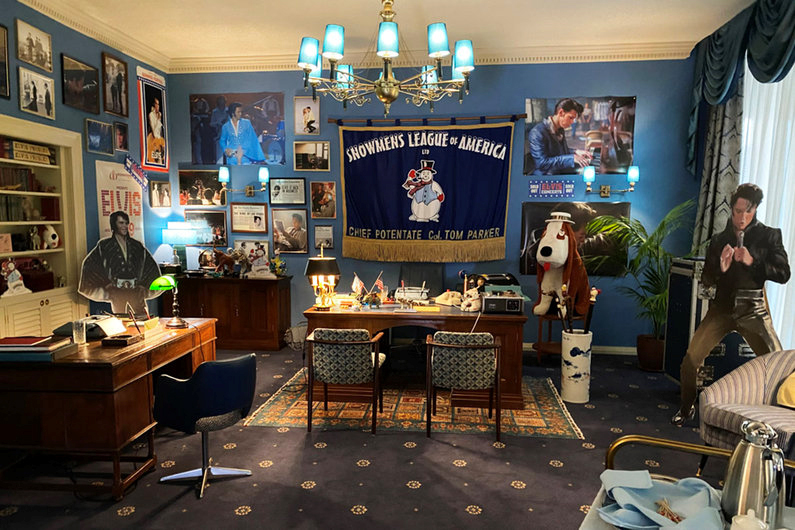
Karen:
What’s more is more, more.
CM: More more is more, you know…and every piece of the dressing is thoughtful. It’s not just stuff to fill corners. And I think that ability to just know about volume—because until one works with Baz, one does not understand volume. I remember doing GATSBY, the flowers scene. Do you remember that, Bev? Remember, Karen? And it was actually like a vacuum. It was like the black hole of artificial floristry, wasn’t it?
Karen: Yeah, there were so many! And then Bev went and got more., much more! I think we were all out getting more.
CM: I don’t think there was one white artificial flower left in Sydney.
Lisa/SETDECOR: With that perspective, since CM brought up the Colonel’s set, Bev, do you want to talk in a little more detail about the layering? I know there was a lot of visual merchandising, Elvis merchandising, in that set. I assume that you created that from research and reference. What went into layering that set, in particular?
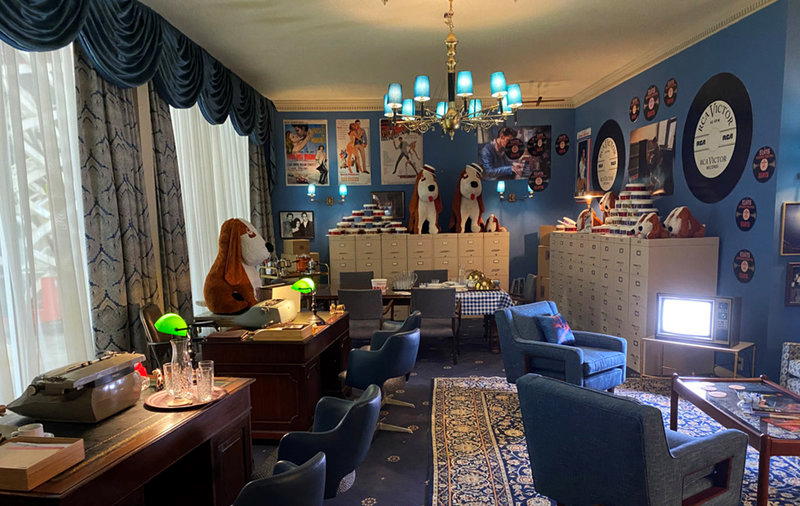
Bev: Yeah, that Colonel’s office was all based on reference, but we had a bit of creative license because of the timeframe. I mean, the Colonel had a few offices, but some parts like the row of filing cabinets were very distinctive, and we had those manufactured. The photographs and the merchandise were based on true reference. We had Austin photographed in iconic Elvis poses. So, because we’re in the ‘70s, we had that mix of color and black and white. And hats off to Baz, because I had printed some of these larger format photos in color. Baz walked on set and mentioned, “Well, that’s such an iconic photograph of Elvis, but it was in black and white, you know. Can you just please tweak that and change it to black and white?”
And, yes, all the merchandise was printed from scratch. We ran into a few clearance issues, but we overcame them as you do, and just kept on. We tried to personalize the Colonel with his trinkets, and really convey that carnival aspect — he’s an ex-carnival person, an ex-carny, so his collection of trinkets, his collection of canes, his photographs, his memories from his previous world as well as the merchandise. The beauty of the Colonel is that he marketed Elvis, you know, with the games, with the nail polish, with the dolls, the stuffed dogs, jewelry, anything you could possibly imagine. The Colonel was really into the merchandise, which we were able to show in that room.
Karen: CM, isn’t it true that the Colonel was the first person to do the visual merchandizing thing for an artist?
CM: Yes.
Karen: So he kind of created that genre, which is now sort of ubiquitous. Baz always found that fascinating. And of course, when we went to Graceland, we were photographing it all, because it was just the most bizarre thing, all these pins and little blurbs about him, or hats, or whatever the objects were, they were just always such a focus. And I think Bev did such a beautiful job to bring it all together in that set.
CM: Also, another little quirky thing that Baz discovered in the process of writing about the Colonel, was his obsession with elephants. And if you look in that set, Bev has, I think, completely and utterly purchased every single period appropriate elephant tchotchke in Australia.
Lisa/SETDECOR: And tons of little snowman tchotchkes, you must have collected quite a lot of them…
Karen: Yes, that was sort of his motto, wasn’t it? That he was snowing people. Baz was always interested in those types of symbols and envisioned that they would recur in the film.
Initially going into it, when we were researching early on, I didn’t know much about the Colonel. It was really great to delve into that world, that carny sort of world, and the collections of things and the obsessions that he had. I think that set embodies all of those things that Baz was really interested in exploring.
Lisa/SETDECOR: Speaking of the carny world, the Carnival set was such a great metaphor for the story as a whole. Can you talk a little bit creating the set? I know there were things that you fabricated and things you had to find, and there were issues with weather. We’d love to hear about how the Art Direction and the Set Decoration supported each other in such a specific set.
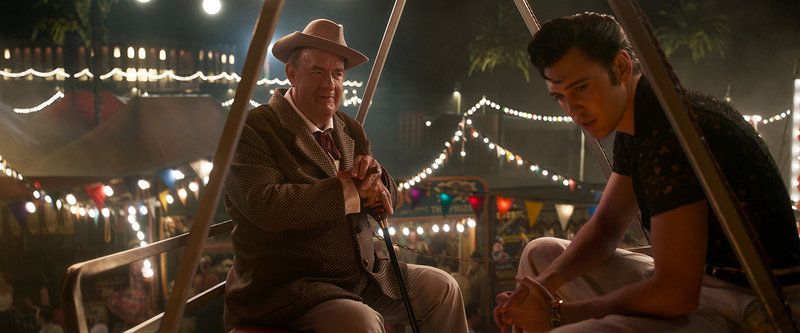
CM:I remember the biggest moment of all was we needed to find a period-appropriate Ferris Wheel. Baz wanted one like the one that appeared in an actual Elvis movie. It’s a very specific style and brand, and we managed to find the exact one at that scale in Australia. We had it brought to us and constructed so Baz could see it, which he did and he realized that it was too small. So, we needed to find a much bigger one, but that changed the staging. In all the rehearsals, everything had been done with two people sitting side by side. But in the big Ferris wheel, they were actually carriages instead a single bench seat, and the Colonel and Elvis would sit opposite each other.
It was one of those serendipitous moments, where finding the scale of the original Ferris wheel not being right, and having to pivot in terms of how the seating of the people within the Ferris wheel would be, altered the staging for the better. And so much of that set was set dressing…there were a few period-appropriate carnival rides…but that particular set just leaned into set dressing, with all of the painted canvases and all of the dressing, including the tent that the carnies have their first scene in when the Colonel hears about Elvis for the first time and hears the record. Please speak to that Bev.
Bev: Oh, you know, I look at that set and I’m just in awe of the painted canvases. I thought they were incredible, the graphic work that went into to those really gave that ‘50s vibe, and I honestly feel my set dressing is quite minimal compared to those beautiful, beautiful canvases. And the vehicles! The period vehicles, all painted appropriately, and those canvases just set the scene.
It was a very tough location to be to be filming in, and a big flood came through. We had a sort of tropical small cyclone that visited the set the day before we were shooting. So, a bit of a cleanup had to happen, but, again, visually it all was fantastic…really pretty drone shots.
Karen: It wouldn’t be a Baz Luhrmann film without a flood. I mean, on GATSBY, we had a rather large flash flood when we’re in the middle of filming. And then for AUSTRALIA, I remember flying in to look at the homestead set, and as I flew over the house, it was surrounded by water. It literally had just been flooded. So I think that’s it’s a trifecta of floods…but of course, you know, we all make it through the adversity.
Lisa/SETDECOR: One of the sort of overarching questions I had was how you successfully walk the line back and forth between naturalism and heightened realism…and the process and the challenges of creating this kind of visual language. The film does such a remarkable job of doing both at the same time and fulfilling the need for there to be grounding points that are recognizable, like Graceland where you had to be more specific, and then other areas where you had more open interpretation. And so if the three of you could discuss that process a little bit, that would be great.
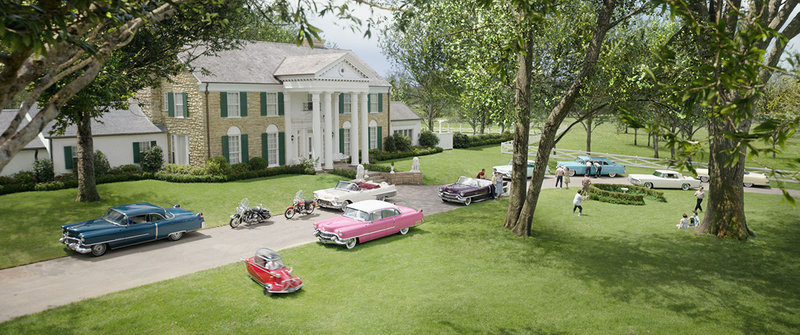
Bev: In Australia, we don’t have a lot of American iconic ‘50s import, most of ours have a very English background. And so it became very apparent, due to past experience, that everything for Graceland would have to be manufactured, including the sofa, and the TVs that Elvis was obsessed with, lamp bases, furniture…everything had to be manufactured. So that went into pre-production quite early on to ensure we could get things made within the timeline. I think that’s really important, because Baz always wanted the version that we see in in the film, the white version of Graceland. It’s the version that exists today. Elvis redecorated numerous times, so during the time frame of our film, it may not have been that exact white version, but it’s how Baz wanted to depict Graceland, so it would be instantly recognized. We had a few challenges with manufacturing items, and there were issues with the basketweave wallpaper, trying to get a texture onto that paper. Everything we wanted to print was very flat and almost started to strobe on camera. But again, through trial and error we got there in the end. I think we pulled it off, because even though some of the lamp bases or fabrics were not exact, I think, visually, it just sums up Graceland.
Lisa/SETDECOR: Yeah, definitely. One of the things I think is so brilliant, successful about the design of this film is that it’s not a documentary, it’s not word-for-word. There’s a way that you’re getting at the emotional state of the character, that you are respecting the realism of the story, but also creating a symbolic language throughout the movie. So, if you all could talk a little bit to that, because it’s a very difficult tightrope to walk to do that successfully.
Karen: I think it is. But I think you’ll find the truth is important to Baz. So for us, we all have to really live that truth and understand it. That’s why the research period is so long…and that is a very important time. We tend to build a research bible, a book of key images. You can look at them, and you can look at the movie, and you can see that historical accuracy, but then you can also see this sort of heightened part of it whereby Baz and CM push the reality a little bit.
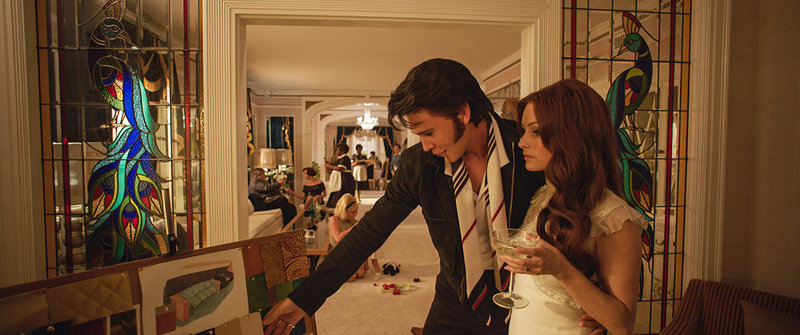
Catherine’s got an incredible ability with the fabrics and patterns and colors and palettes and everything like that. It’s all in the set and in the costumes, and the support of the history with these imagined new textures and perspectives. She has an incredible skill to bring all of those things together. I think that’s why the film becomes where you believe it. It’s a real environment, but there’s also a magic sort of side to it.
I’ve found the same with GATSBY. We knew that book inside out. And there were words on that page that you can see in the film. But there were also a million orchids, like way too many orchids, or way too many of this, or so many cars, the colors were a bit brighter, the cars are a bit souped up. So, again, with ELVIS, that was the set. It’s very much Baz…the Baz way is that we know the history, but then we can we level up to this magical aspect. We support his way of telling stories by sort of pushing the design as far as we can.
CM: True. Baz has always said to me…and I think it’s one of the best lessons he ever taught me…there’s a big difference with what it feels like to be there and what it actually looks like, and we’re in the business of making it look how it feels to be there.
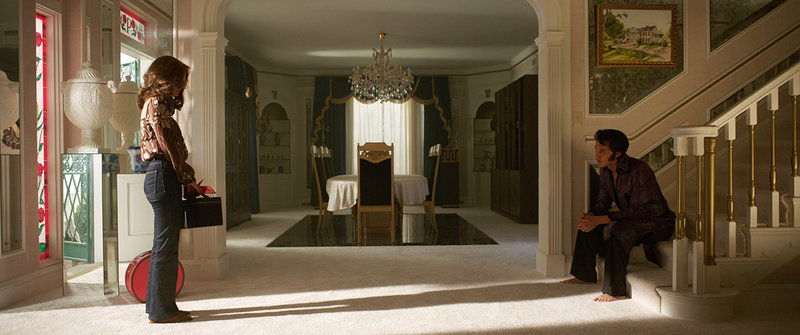
And so there’s very much the kind of lens that says, “Well, what did it feel like to be there?” How do we communicate that to an audience? How do we select things that are historically true, but through selection, amplify the situation, amplify the drama, amplify the audience’s ability to understand who this person is?
If you were to break the movie down, and say to me, or Karen, or Bev, “I want you to show me that that object is actually historically accurate.” Probably 99% of the time, we could find an image that was almost a picture-perfect match. But I think it’s Baz’s ability to stimulate our soul to recombine these things into images that, as you’ve pointed out, kind of take you beyond it just being a documentary because it’s Baz’s storytelling of Elvis’s life against the backdrop of three decades of American history.
And so, I think that’s one of the most interesting things that I have learned from him. I always think about that. I always think, what would it feel like? What did it feel like to be there? And how do you translate that so the audience understands it?
Karen: I think, CM, the Beale Street set for me really encapsulates what you’re saying there. We had two blocks. We built a backlot, we literally got a steamroller out and built a road and then built two blocks of Beale Street. Now, those shops…we found old plans of what used to be on Beale Street, whether it was a laundry or a photo studio, or a shop, whatever it was…and we tirelessly researched this. We thought, for Baz, he wanted to have that feeling of a guy seeing his future or seeing something that connects. You know, he’s come from quite a poor background, he goes to this place Beale Street, and he finds himself there. He finds his style, the way he’s going to dress, he sees the way other people are dressing. He hears music.
Baz wanted to get all of that energy and that feeling into two city blocks. So, we put it all in those blocks. We had so much going on…all the graphics, all the colors, the cars, the Club Handy set. All of that was just in these two blocks. And I think that the film really gives you that experience…you really feel that music, you feel that time, those 1950s, the year 1957. And that is Baz’s vision right there, to get as much of that the essence of that feeling that the guy was having in this one set.
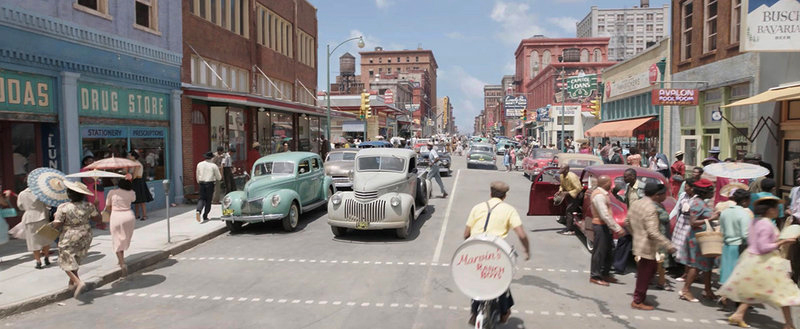
Lisa/SETDECOR: It’s a great example, because when I first saw the film, it feels real, down to the peeling paint and the stains on the windows, but it also feels evocative at the same time. Logistically since we’re talking about that set, what kind of timetable did you have for executing construction and dressing because it seemed like an enormous set…
Bev: The physical dressing, we really got down to a few weeks because we pre-manufactured the parking meters and the streetlights, we had the neon signs made off site. So the assembly came together quite quickly, but it was certainly months of evolving with especially the signage, i.e. real neon versus LED neon and how that reads on camera. There were a few design discussions involved with the neon and lighting with the DOP. But, my footprint was quite small, because we had to work on site.
Karen:
It was being built for like 12 weeks pre-pandemic, before we shut down. CM, maybe you can speak to that. But I mean, it was like, we just left it there.
CM: We shrink-wrapped it! It was a very strange process, but the two city blocks set was shrink-wrapped. And you know, the Australian climate is very harsh, so when we came back, there had been discoloration. So we needed to repaint the set.
Bev is the unsung hero of the street, because every single window was immaculately dressed, as well as the sidewalks. It was extraordinary. Each particular shop had its own DNA, and I think Bev did an incredible job to get the texture of every window, but also to be really clever with depth, because we didn’t want to build the back of the shops and we also wanted varying depths. My favorite dressing pieces were those bottle pyramid stands. I’d never seen them before, or since. I now own them. I stole them. I don’t know what I’ll do with them. But they’re just extraordinary. They’re sort of like a circular Christmas tree, sort of rings with holes to put bottles on that were in the liquor store on Beale Street. But it’s this level of attention to detail.
I remember walking into the art department one day at 7:30 at night. Every single person was sitting, hand-writing price tags, they’re writing on little, tiny, period-appropriate ticket swing tags and tickets and little cards with printed frames because this was period correct. And I don’t know how many price tags they wrote. But I walked on out, we were filming that night, and I came back in at 9:30, and they were still there. Writing price tags. It’s that attention to detail.
Lisa/SETDECOR: That’s a great anecdote. Jumping cross country from Memphis to the Las Vegas penthouse, the layering of pattern and texture in that set was an interesting nod to the ‘70s, but it also had sort of a Victorian level of lushness. And the bed itself seemed like quite a feat from a set dressing standpoint. Bev, can you talk a little bit about this set?
Bev: It was the layering of the use of fabrics on the wall, and we had Hilbert tiles to act as a bedhead. Different velvets in the drapery and in the sunken sofa. They’re all very lush fabrics, and it’s almost a clash of colors that works really, really well. That’s Catherine. When I read the script, I originally thought the set was going to be in red tones, and to have it be designed more into the navy and the golds gave it a different edge, which I was really excited to work on. So, lots of layering, different textures, and that’s what really, really works in in that room.
Karen: It’s very much a heightened kind of interpretation of just a few photos that we managed to find. I think that it speaks to, again, CM’s and Baz’s collaboration, with all the fabrics and everything just sort of creating that heightened version. It was like getting that essence of who this guy was at this point in his life. I think that really comes out.
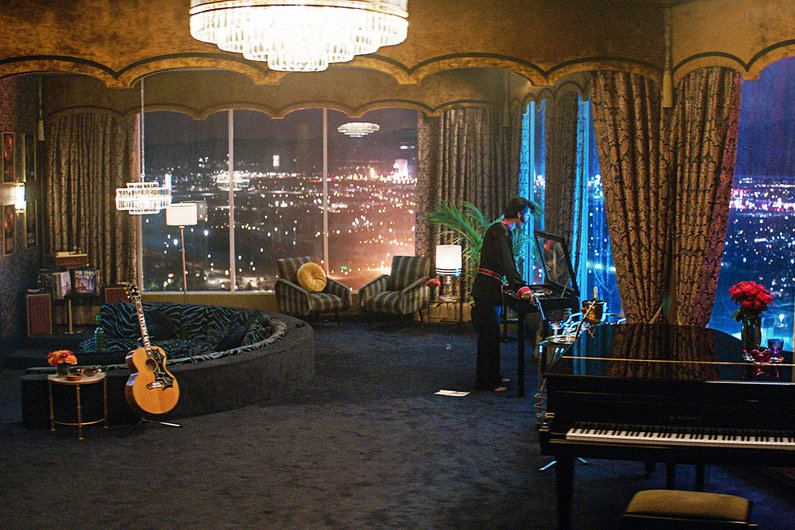
CM: Baz kept talking about it wanting to feel like it was a sarcophagus, and a golden cage. That fit as well into the design for the elevator set, where Elvis is going up and down…the fact that he was kind of being suffocated by his environment. So that was sort of the key.
Lisa/SETDECOR: It’s interesting that you said “sarcophagus” because my notes when I was preparing for this were “Victorian vampire”…
Karen: He was a bit vampiric. He didn’t really go out anywhere, did he? He was literally imprisoned in this hotel. And like a trick pony had to keep performing.
CM: Vampire is a really good word. Baz kept using that all the time.
Elvis actually took over the entire penthouse floor of the hotel. In the lobby of the penthouse floor, there was a sunken lounge. So we co-opted that and put that into his bedroom suite. In our movie, we see him only in the bedroom section of the suite, but it tells the full story. That hotel set, for cost reasons, actually served in different variations to a number of purposes, including the Colonel’s office at the International, and this speaks to Bev’s flexibility as a decorator. It was all designed in segments so that it could be partitioned off. And you know it is the magic of set decorating that allows you to believe in each of the completely different spaces.
Lisa/SETDECOR: And it seemed like the penthouse kind of had a visual language that tied into his bedroom in Graceland, so you kind of see the progression visually from that bedroom.
Bev mentioned red earlier…the tour bus is a symphony of red. So, the challenges of doing something in one color, almost one color entirely and creating that level of texture is quite phenomenal…
CM: That is certainly one of Karen’s triumphs, she did an incredible job on that tour bus.
Karen: I think one of the biggest challenges of that was a bus interior has all these incredible compound curves. So, getting fabric and paneling to work within the confines of the shape of a bus was quite the challenge wasn’t it, Bev? The level of quality upholstery that went in that was amazing.
There’s actually a strange old video of his bus. Elvis didn’t like to fly. So, he would always travel in this bus, and it became an extension of his home, and the later hotels. And with Baz’s idea of making things feel a certain way, it had to have that same sort of opulence. The palette was red, but we pushed the design of it a little bit…the gold, the light fittings, Bev found incredible buttoning, and all sorts of details that would just add to those layers.
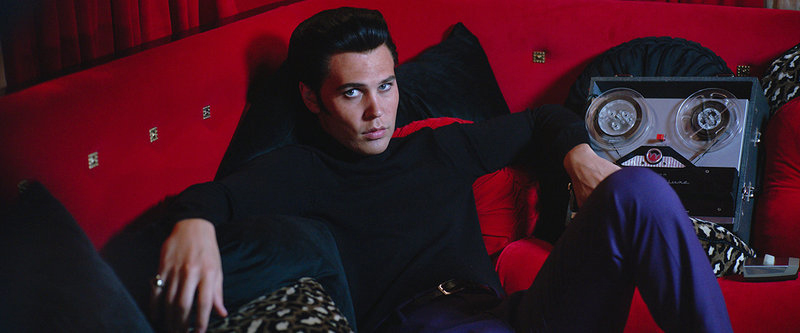
Lisa/SETDECOR: Did you custom dye the fabric? To get the reds to talk to each other, the process of finding the fabric that all went together…that’s not easy either.
Bev: No, we didn’t have to custom dye the red, but we did print the striped fabric to work with the red that was on the on the ceiling. We did tweak it a little bit, but we were very lucky with the reds that we found off the shelf, to be honest.
Karen: It was exhaustive trying to find that bright red. I remember, Bev, that you offered up a lot of choices, and Baz loves fabrics. The color is extremely important, so he had to sign off on all of those colors. With a lot of directors, you can show them a concept frame and they’ll trust that you’ll do it. Baz really wants to feel that color and the textures. So, we mocked up the bed in the back.
Lisa/SETDECOR: Clearly, this project was massive. If you could talk a little bit about the structure of your department, like assistant set decorators? Do you have your own shop manufacturing the furniture all the time? Bev, why don’t you start because a lot of times, set decorators don’t get the chance to talk about the scope of their department as much. I think people are more familiar with the scope of the art department on a project of this scale.
Bev: Sure. I had one assistant set decorator. We’re very, very lucky to have an in-house prop manufacture department, which was quite small, but, as long as I had a mold shop operational, we could manufacture all that was required. We had our own scenic artists, about two to four people just constantly painting the props or the Set Dec items. I do, in Australia, work with more buyers than the American system. As you know, we don’t have prop houses, so I’ve really got to try and find what could possibly be out there to start with.
I have three senior buyers, two junior buyers, a Set Dec drafts person, a couple of PAs and a lot of casuals, my super swing gang, and I have a great lead man. Our schedule for dressing and day-dressing sets became very, very tough with the turnaround that construction needed to bump sets out on one particular stage, to allow them to be bumped back in that night or the next day. So I did have quite a big swing gang team. And I had to rely on art directors and graphics, and then there was the props team as well, so the propmaster was also key.
It just seemed to be a very constant pace. But with all the experienced people and the teamwork, we pulled it off, which is wonderful to see.
CM: It’s an unusual way to work, but because I see Bev as an integral and senior part of the team, I put a lot of pressure on her to also oversee the propping, because to me the propping is an extension of the Set Decorating…and for that whole area I like to have a continuity of purpose. So she sometimes is also lumbered with responsibilities she doesn’t want because I need her eye on it or I need it to feel part of a bigger gesture.
Also, people tend to forget that everything, the chair, the carpet, the wallpaper, the rug, the curtain, all of that is set decoration, you know, it doesn’t just appear magically.
And we have Ian Gracie, our supervising art director, who is the kind of very glue that holds it all together…these three incredibly strong, creative women who can work together, who support each other and who have done so for years. I am very proud of this great team.
Karen: Definitely, I feel like I’ve taken a lot of what I’ve learned through this collaboration with CM and embed them into the other projects that I do. Prop masters always find me very annoying, because I’m always on top of them…I want to see what they’re doing. The same with the set decorator. I want us all to work together. It’s just something that comes from the Baz Luhrmann/Catherine Martin School of Filmmaking that we’re all in this together as a team.
Lisa/SETDECOR: Well, it is so nice to talk to all three of you and to hear your experiences and also to hear from a team that has worked together so seamlessly for so long. Thank you.
DESIGN YOUR FUTURE TODAY!
Interior Designers Institute was founded in 1984 and is one of the few Interior Design Schools in California offering an Avocational Certificate Course, Associate of Arts Degree in Interior Design, Bachelor of Arts Degree in Interior Design, and Master of Interior Architecture Degree and is nationally accredited and also accredited by CIDA, Council for Interior Design Accreditation.

